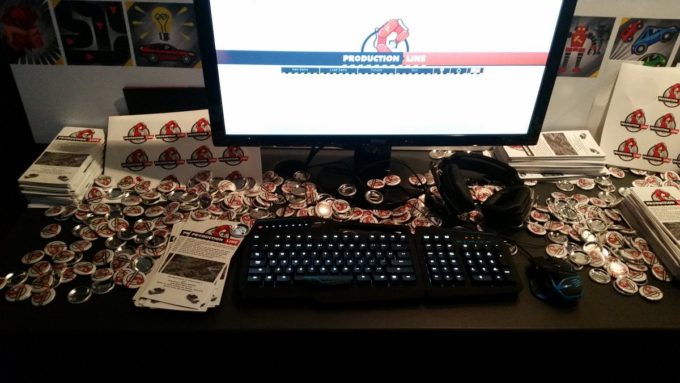As people who follow me on twitter may know, I find appearing at trade shows really really tiring. The biggest one in the UK is #EGX and I’m at it right now. We have a fairy standard 2xPC booth with branding etc, a whole ton of leaflets and badges and stickers etc, and I have my white Production Line jacket and yellow hat. I gave a talk today on the stage and we are generally watching people try the game.

The problem with me being at EGX is threefold. Firstly, its a LONG show, 4 days long and ending at 7PM most days (an hour too long if you ask me). Secondly, its a really loud socially crowded place, which I am emotionally and personality-wise unsuited for, and Thirdly its designed in the normal manner of shows for Gamers.
Its the third point which I think is interesting.
We all know that plenty of gamers are introverts. Plenty are shy or quiet. Plenty are over the age of twenty, or thirty, or in my case, even forty. We all know that video games are just a medium, like books, movies or the theatre, there is a vast range of different types…
And yet game shows act entirely like its a festival for (mostly) make teenagers.
They are generally VERY LOUD. There is a lot of flashing lights, and people with microphones SHOUTING and getting VERY EXCITED. There are competitions for cosplay, highly competitive LAN party things, and the whole vibe is like a loud rave with computer screens. In other words, it is directly aimed at a certain cross section of gamer, mostly the shooter or First-Person Shooter or AAA budget RPG crowd.
Fans of farming simulator, or of Civilisation style games, or city builders etc.. do not seem to be at all catered for by the aesthetic of these shows. I think this is a mistake, and the shows should do more to cater to different, less LOUD and SHOUTY game styles. Why not divide EGX or similar shows into 2 or 3 sections. Have the loud shouty FPS game section, have the young cool cosplay area with minecraft etc and also the merchandise stuff, and then have the quiet(ish) strategy / sim / boardgame / developer sessions area.
Every time I go to GDC, all the parties are really loud, and everyone stands around shouting about how the parties are (yet again) too loud. What we need are events and shows that specifically cater to people who love games and game development, but don’t want to yell at each other through strobe lights all day. Like I say, games are just a medium. Imagine of literary festivals assumed all the attendees were just readers of crime fiction, or of thrillers. It would be mad. Cater to everyone.